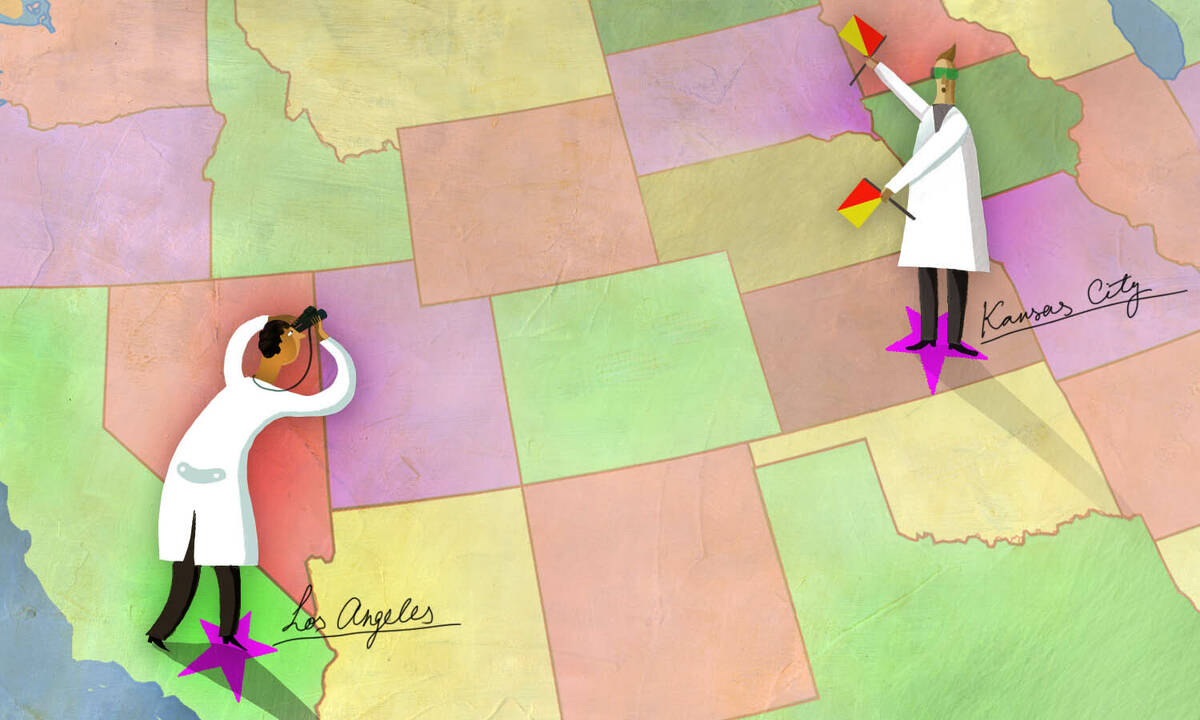Organizations Feb 2, 2024
Could Remote Work Hurt On-the-Job Learning?
We are more likely to learn from our collaborators when we are in close proximity to them, a new study finds.

Yevgenia Nayberg
Four years since the start of the Covid-19 pandemic, many workers still find themselves logging on from home at least part of the time. Zoom meetings with teammates, once thought to be a short-lived pandemic trend, have remained on work calendars. And these geographically flexible workers report increases in productivity and satisfaction.
So does that mean that we no longer need to see each other in person? Is proximity dead? Not when it comes to learning through collaboration, says Hyejin Youn, an associate professor of management and organizations at the Kellogg School.
In analyzing more than 17 million scientific publications over the past 45 years, Youn and Frank van der Wouden of the University of Hong Kong found that researchers who collaborated locally were much more likely to gain new knowledge from their teammates than those who collaborated at a distance.
That’s because being together physically—reading body language, mulling a problem at a whiteboard, and teaming up to use specialized laboratory equipment—is especially valuable when knowledge isn’t yet codified.
“We learn from each other in person more than we think we do,” Youn says. “That’s part of our success as humans, especially when it comes to knowledge that is new, not yet defined. You have to be present to watch and learn. And collaborating locally is the way to do that.”
How collaborations lead to new knowledge
Even before the COVID-19 pandemic, geographical distance between people and organizations seemed increasingly irrelevant. Advances in communication and transportation technologies seemed to flatten the globe, and workers in both academia and industry found that collaboration and knowledge transfer could take place successfully across institutional and international borders.
But Youn wasn’t convinced that collaborating remotely was a perfect substitute for being together in the same room. Why, then, was knowledge and innovation still largely concentrated in urban cities? Why was business travel still so popular? These trends would seem to suggest that knowledge creation and transfer might benefit from togetherness.
So, to study the effect of geography on learning among collaborators, Youn teamed up with van der Wouden, then a Kellogg postdoctoral scholar, to study whether and how knowledge production depended on physical proximity.
“We learn from each other in person more than we think we do.”
—
Hyejin Youn
The pair analyzed data from Microsoft Academic Graph that included information on millions of academic publications from authors who published their work between 1975 to 2018.
Youn and van der Wouden wanted to identify scholars who had gained new knowledge from their previous collaborations. A good proxy for this, they realized, was doing research in a new field: someone who started their career in one academic discipline (materials science, for example), then collaborated with authors from another discipline (chemistry), and ultimately published a paper in that new field (chemistry) as a sole author. This seemed like relatively straightforward evidence that the scholar had learned from their earlier collaboration. Though single-author academic papers are rare in many disciplines, the team still found 1.7 million authors who met this criterion.
Then, they identified the geographical locations of these 1.7 million authors and their collaborators, right down to the location of the author’s building. (For example, if the author was listed as being from Harvard University’s psychology department, the building housing the psychology department was considered their location.) Collaborations were considered local if the authors were less than 700 meters apart, about a 10-minute walk.
They also analyzed the authors’ career stage, the ranking of their institution, and the number of authors on their group publications.
To investigate whether scholars learned from their collaborators, the team calculated a learning rate. That rate—the percentage of scholars who first collaborated with scholars in a new field and later published a paper in that field—was calculated for local and nonlocal collaborations within each academic discipline.
The team also calculated the learning premium for collaborating locally versus nonlocally. For example, if a field had a local learning rate of 10 percent and a distance learning rate of 5 percent, it would show that scholars who collaborated locally were twice as likely to learn from that collaboration.
Who has the most to gain from local collaborations?
Youn and van der Wouden found that local collaboration among the scholars they studied had decreased markedly over time—from 75 percent of collaborations in 1975 to 60 percent in 2015. Throughout that same period, the average geographical distance between collaborators doubled to nearly 2,000 kilometers.
“Thanks to technology, we collaborate across great distances even more now,” Youn said. But that accessibility comes at a cost. “The longer the distance between collaborators, the less likely you are to learn from each other,” she says.
Indeed, across all academic disciplines, the learning rate was greater for local collaborations than for long-distance collaborations.
The rate wasn’t equal among disciplines, though. In fields like history and political science, distance had a negative impact on learning, but a small one.
But researchers in science and engineering were much more affected by distance. Geologists, for example, had a large learning rate from local collaborations. And geographical distance most harmed scientists in chemistry, materials science, and engineering. Their learning rate was much lower in nonlocal collaborations, perhaps because these fields rely more on instruments and equipment that require in-person collaboration.
And today, scholars have even more to gain from local collaboration. The learning premium from collaborating locally has increased from 50 percent in 1975 to 85 percent in 2015, the team calculated.
Certain scholars had the most to gain from local collaborations, the analysis found, including those in the early stages of their careers and those at lower-ranked institutions.
“That’s understandable, because early in your career, you still need to acquire knowledge, and you have to be present to do that when knowledge isn’t yet codified,” Youn says. “It’s like riding a bicycle. You can’t learn how to ride a bicycle by reading a paper.”
Work from home? Not if you want to learn from colleagues.
Of course, the world has changed since the most recent paper in the dataset was published in 2018. Now, meetings over Zoom and Microsoft Teams are much more common, even among local collaborators. And while operating remotely once seemed like a temporary accommodation, many companies are adjusting to a new reality in which workers demand to work from home, at least part of the time. So how will that affect learning in the future?
People who work from home may be missing out on opportunities to expand their expertise, which could have career consequences, both in the short term and down the road. “It could result in a knowledge disparity and segregation,” Youn says. “Especially if you’re early in your career. You may miss collaborative learning opportunities that could ultimately benefit your career.”
Too much remote work could also have larger implications for innovation, which often emerges from teams exchanging ideas. “If you want to be innovative, if you want to collaborate and learn from each other at the cutting edge,” Youn says, “you need to be in person.”
That’s not to say all collaboration needs to be local. Learning can happen at a distance, as Youn found when her coauthor van der Wouden was hired as a professor at the University of Hong Kong toward the end of this research. Still, Youn says, it was difficult to coordinate Zoom calls and “not the same as working together in person.” And she thinks if the move had happened earlier, while they were thinking through key concepts and ideas, the challenges would have been far greater.
Youn suggests companies should find the right blend of having employees work from home, where they can be productive, and bringing them into the office, where they can work together to create new knowledge; firms focused on innovation should be particularly careful to find the right balance. Companies looking to expand their knowledge portfolio should also look to establish offices in regions where that knowledge is located, such as Silicon Valley for tech or Washington, DC, for government.
“Bring people together so they can exchange ideas in person,” Youn says. “We are incredibly good at learning from each other, especially in these murky ways that can lead to innovation.”
Emily Ayshford is a freelance writer in Chicago.
Van der Wouden, Frank, and Hyejin Youn. 2023. “The Impact of Geographical Distance on Learning through Collaboration.” Research Policy.



